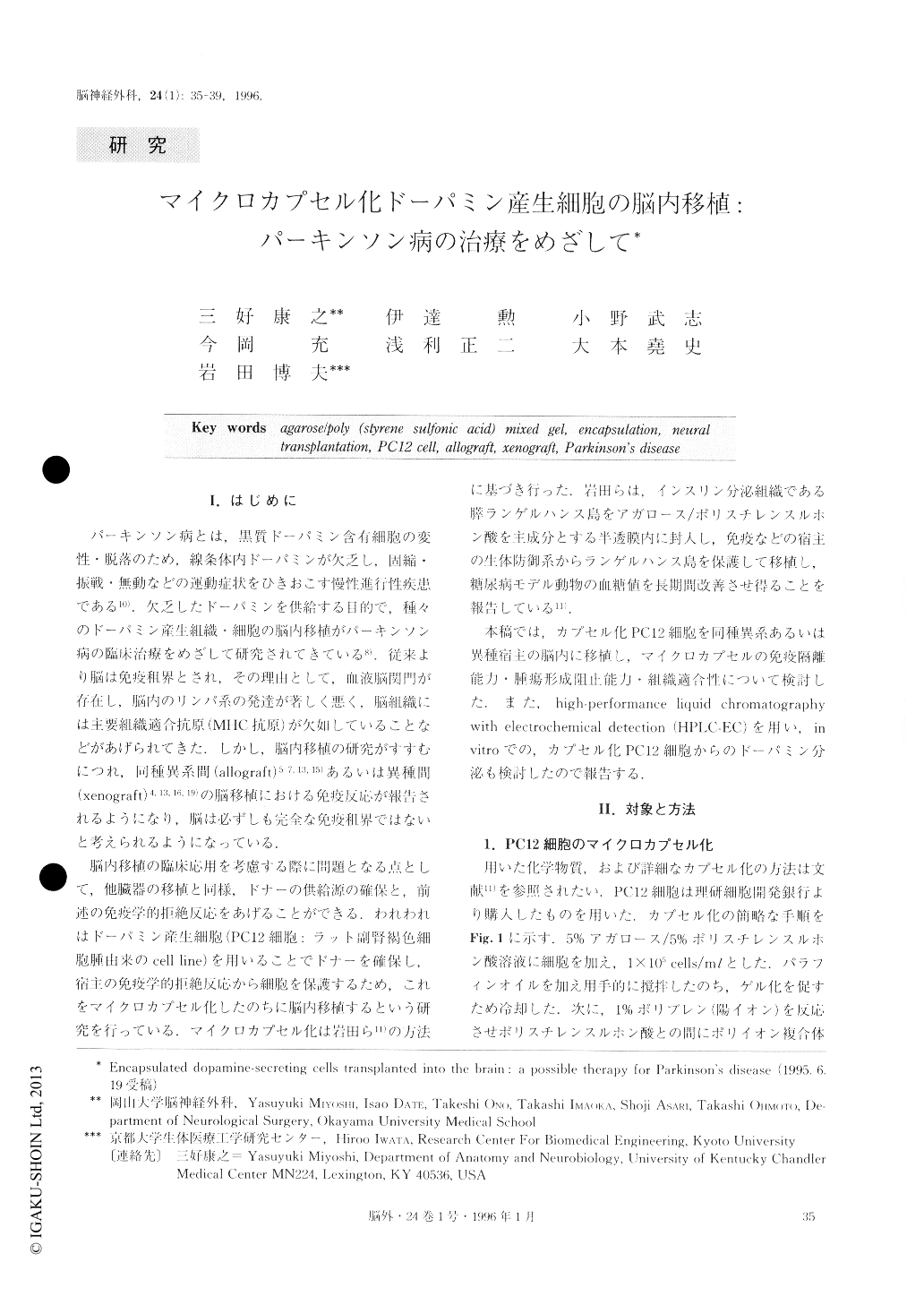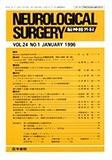Japanese
English
- 有料閲覧
- Abstract 文献概要
- 1ページ目 Look Inside
I.はじめに
パーキンソン病とは,黒質ドーパミン含有細胞の変性・脱落のため,線条体内ドーパミンが欠乏し,固縮・振戦・無動などの運動症状をひきおこす慢性進行性疾患である10).欠乏したドーパミンを供給する目的で,種々のドーパミン産生組織・細胞の脳内移植がパーキンソン病の臨床治療をめざして研究されてきている8).従来より脳は免疫租界とされ,その理由として,血液脳関門が存在し,脳内のリンパ系の発達が著しく悪く,脳組織には主要組織適合抗原(MHC抗原)が欠如していることなどがあげられてきた.しかし,脳内移植の研究がすすむにつれ,同種異系間(allograft)5-7,13,15)あるいは異種間(xenograft)4,13,16,19)の脳移植における免疫反応が報告されるようになり,脳は必ずしも完全な免疫租界ではないと考えられるようになっている.
脳内移植の臨床応用を考慮する際に問題となる点として,他臓器の移植と同様,ドナーの供給源の確保と,前述の免疫学的拒絶反応をあげることができる.われわれはドーパミン産生細胞(PC12細胞:ラット副腎褐色細胞腫由来のcell line)を用いることでドナーを確保し,宿主の免疫学的拒絶反応から細胞を保護するため,これをマイクロカプセル化したのちに脳内移植するという研究を行っている.マイクロカプセル化は岩田ら11)の方法に基づき行った.岩田らは,インスリン分泌組織である膵ランゲルハンス島をアガロース/ポリスチレンスルホン酸を主成分とする半透膜内に封入し,免疫などの宿主の生体防御系からランゲルハンス島を保護して移植し,糖尿病モデル動物の血糖値を長期間改善させ得ることを報告している11).
本稿では,カプセル化PC12細胞を同種異系あるいは異種宿主の脳内に移植し,マイクロカプセルの免疫隔離能力・腫瘍形成阻止能力・組織適合性について検討した.また,high-performance liquid chromatography with electrochemical detection(HPLC-EC)を用い,invitroでの,カプセル化PC12細胞からのドーパミン分泌も検討したので報告する.
Encapsulation of neurosecretory cells within a semi-permeable membrane may possibly isolate the enclosed cells from the host immune system and allow inward diffusion of nutrients and outward diffusion of neuro-transmitters. Morever, the encapsulation procedure may prevent the tumor formation of enclosed cells, when they are derived from tumor cells. In the present study, PC12 cells, a dopaminergic cell line derived from a rat pheochromocytoma, were enclosed within an agar-ose/poly (styrene sulfonic acid)(agarose/PSSa) mix-ture and transplanted into the brains of rats (allogeneic transplantation) or guinea pigs (xenogeneic transplan-tation). Tyrosine hydroxylase (TH) immunoreactive PC12 cells within the microcapsules were observed in all rats and guinea pigs at least up to five weeks after transplantation. PC12 cells were round in shape and of relatively uniform small size. Although PC12 cells occa-sionally formed cell clusters, the formation of a tumor was not observed. The host reaction to agarose/PSSa microcapsules was minimum. The degree of glial fibril-lary acidic protein (GFAP) positive astrocyte density around the microcapsules was similar to that around in-jection tracks. There was no apparent immunological rejection around the capsules. High-performance liquid chromatography with electrochemical detection (HPLC-EC) showed basal and potassium-evoked re-lease of dopamine from the PC12 cell-enclosed micro-capsules in vitro. Although our data is preliminary, we believe that agarose/PSSa microcapsules are promising for producing semipermeable membranes that enable allo-and xenotransplantation of neurosecretory cells into the brain in the absence of systemic immunosup-pression. This approach is expected to be applied in Parkinson's disease in the near future.

Copyright © 1996, Igaku-Shoin Ltd. All rights reserved.


